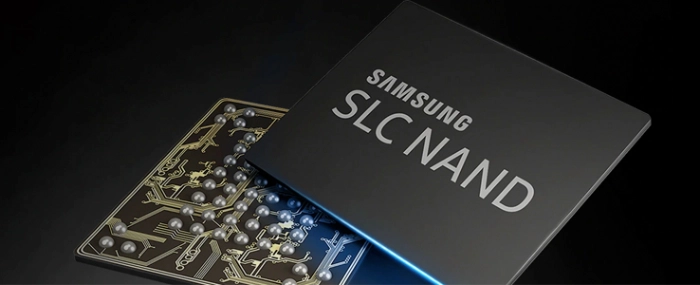
Weakened demand and falling prices lead to NAND flash revenue decline
As manufacturers actively shifted production capacity to 128 layer products, the market turned to oversupply, resulting in a drop in contract prices in 1Q22, among which the decline in consumer-grade products was more pronounced, according to TrendForce research.
Although enterprise SSD purchase order volume has grown, demand for smart phone bits has weakened due to the Russian-Ukrainian war, the traditional off-season, and rising inflation. Client inventories have increased significantly, so it remains challenging for overall bit shipment volume to offset potential decline. In 1Q22, NAND Flash bit shipments and average selling prices fell by 0.5% and 2.3%, respectively, resulting in a 3.0% quarterly decrease in overall industry revenue to USD 17.92 billion.
Although China's smartphone stocking momentum was marginally weak considering the off-season, due to sluggish supply on the part of Kioxia and WDC, Samsung's 1Q22 client SSD shipment bit growth was driven up by an influx of rush orders and North American enterprise SSD client orders also recovered significantly in March. Overall bit shipments increased by 9% QoQ and ASP decreased by 2% QoQ. In 1Q22, the NAND Flash portion of Samsung’s electronics business posted revenue of USD 6.32 billion, up 3.4% QoQ.
Also affected by weak demand for smartphones in China, SK hynix's shipment performance was stifled with mobile being its primary product focus. As the supply of capacity gradually sloughed off the millstone of material shortages, Solidigm has surged client SSD shipments significantly in 1Q22 but the combined shipments of these two brands still declined by 8.4% compared with the previous quarter and ASP was also affected by falling contract pricing in 1Q22, declining by 3%. In the 1Q22, SK Group’s NAND Flash revenue decreased by 10.7% QoQ to USD 3.23 billion.
Kioxia's enterprise SSD shipments continued to grow in 1Q22 and its decline on the mobile side was slightly less pronounced than that of other manufacturers, so overall bit shipments were approximately level with the previous quarter. Benefiting from a rising proportion of high-unit-price product shipments, ASP also remained level with the previous quarter. After taking into account the impact of foreign exchange rates and the contamination incident, Kioxia’s revenue in 1Q22 reached USD 3.38 billion, down 4.5% QoQ.
After the contamination incident, Western Digital further increased the prices of certain products. As a result, ASP in 1Q22 only fell by nearly 1%. However, bit shipment volume was suppressed by the aforementioned contamination incident. After the outbreak of the Russian-Ukrainian war, retail demand weakened and bit shipments declined by 14%, affecting the company’s NAND Flash revenue in 1Q22, which fell by 14.4% QoQ to USD 2.24 billion.
Due to limited capacity supply from Kioxia and Western Digital, Micron's client SSD order volume rose in 1Q22, bit shipments increased by 5% QoQ, and ASP was roughly level with the previous quarter. Upon further analysis, in addition to rebounding wafer pricing starting in February, Micron's enterprise SSD bit shipments also increased significantly, driving NAND Flash revenue to USD 1.96 billion in 1Q22, up 4.2% QoQ.
Looking back at 1Q22, factors including the outbreak of war and traditional off-season led to weakening bit demand for smartphones. However, after the Kioxia contamination incident, tight supply caused NB and server customers to ramp up purchasing to avoid SSD shortages. The above incidents caused overall NAND Flash bit output in 1Q22 to remain unchanged from the previous quarter.
Looking to 2Q22, although war, rising inflation, and pandemic lockdowns continue to slow the growth of consumption, the ongoing shift of mainstream capacity employed by large North American data centers to high-capacity 8TB SSDs will drive enterprise SSD demand growth by 13%, with an opportunity for 2Q22 shipments to gain added ground. At the same time, due to Kioxia’s contamination incident, product contract pricing has risen by 6%. With higher pricing and volume, NAND Flash industry revenue in 2Q22 is forecast to increase by more than 10%.
| Company | Revenue | Market share | ||
| 1Q22 | QoQ (%) | 1Q22 | 4Q21 | |
| Samsung | 6,320.0 | 3.4% | 35.3% | 33.1% |
| Kioxia | 3,384.5 | -4.5% | 18.9% | 19.2% |
| SK Group (hynix + Solidigm) | 3,225.0 | -10.7% | 18.0% | 19.5% |
| WDC | 2,243.0 | -14.4% | 12.5% | 14.2% |
| Micron | 1,957.0 | 4.2% | 10.9% | 10.2% |
| Others | 790.6 | 10.0% | 4.4% | 3.9% |
| Total | 17,920.0 | -3.0% | 100.0% | 100.0% |
For more information please visit TrendForce
